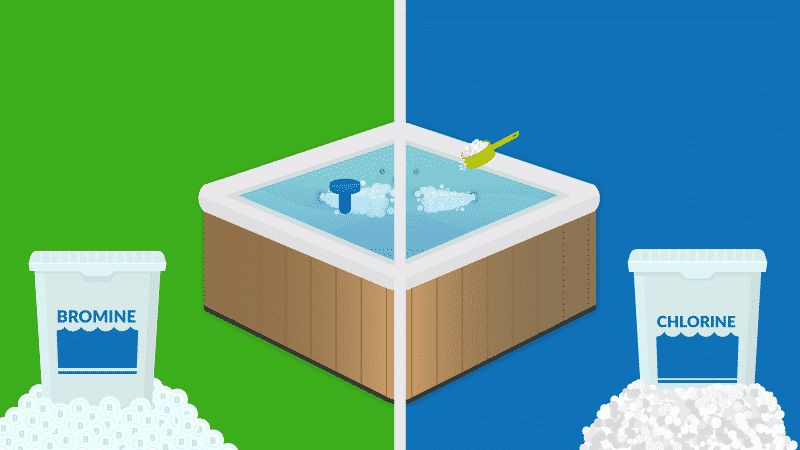Using bromine instead of chlorine in a hot tub is possible, but there are some important factors to consider first. Here is a quick overview of the pros and cons of bromine vs. chlorine for hot tubs:
Page Contents
Quick Answer
Bromine can be used as a sanitizer in hot tubs instead of chlorine. The main advantages of bromine are that it doesn’t produce a strong chemical odor like chlorine and it lasts longer. However, bromine is more expensive, can’t kill bacteria as fast as chlorine, and requires special tablets or cartridges. Overall, chlorine is still the more popular and cost-effective option for most hot tub owners.
How Bromine Works as a Hot Tub Sanitizer
Like chlorine, bromine is a halogen that kills bacteria, algae and other contaminants in hot tub water. However, bromine lasts longer than chlorine because it is not used up as fast in the sanitizing process. It produces hypobromous acid when dissolved in water, which destroys microorganisms.
Bromine is available in tablet and granular form. Bromine tablets or cartridges are designed to dissolve slowly over time, providing a steady release of sanitizer. Maintaining the proper bromine residual (2-4 ppm) is important for effectiveness.
Pros of Using Bromine in a Hot Tub
Here are some of the potential benefits of using bromine instead of chlorine in a hot tub:
- Doesn’t produce a strong chemical odor – Bromine has very little odor compared to chlorine.
- Longer-lasting – Bromine persists longer in water than chlorine before needing to be replenished.
- Fewer chemical byproducts – Bromine does not react with organic matter to produce as many irritating or toxic byproducts as chlorine.
- More stable pH – Bromine has less effect on pH levels than chlorine.
Cons of Using Bromine in a Hot Tub
Here are some of the downsides to consider about using bromine instead of chlorine:
- More expensive – Bromine is significantly more expensive than chlorine. Ongoing costs are higher.
- Slower sanitizing action – Bromine does not kill bacteria and oxidize matter as quickly as chlorine.
- Requires special tablets/cartridges – Bromine cannot simply be added as a liquid like chlorine. It must use special slow-dissolving tablets or cartridges.
- Potential skin irritation – Bromine can cause skin dryness or irritation in some people, especially at higher concentrations.
- More difficult water balance – Maintaining proper water chemistry is trickier with bromine than chlorine.
Is Converting to Bromine Difficult?
Switching from chlorine to bromine as the sanitizing agent in a hot tub requires some important steps. You cannot simply start adding bromine to the water.
Here is an overview of the conversion process:
- Drain and refill the hot tub with fresh water.
- Remove any buildup and thoroughly clean the tub.
- Balance the pH and total alkalinity of the water.
- Add a shock treatment to oxidize contaminants.
- Run the filtration system for at least 8 hours before adding bromine.
- Follow manufacturer instructions for adding and maintaining bromine tablets/cartridges.
- Frequently test and adjust bromine levels until optimal sanitizing residual is reached.
It takes time for the bromine to build up and become fully effective. Chlorine cannot be present during this process or it will interfere with bromine sanitizing. Overall, the conversion process is not necessarily difficult, but it does require patience.
Is Bromine or Chlorine Better for Skin?
When it comes to skin irritation and sensitivity, bromine may have some advantages over chlorine:
- Bromine has less noticeable odor, which can be an irritant for some people.
- It produces fewer chemical byproducts that can cause skin reactions.
- Bromine doesn’t dissipate from water as quickly, resulting in a more stable pH beneficial for skin.
- However, bromine residue on surfaces can still cause irritation during contact. Proper water balance is key.
- High levels of either sanitizer can dry out skin. Bromine may have a slight advantage but both can cause issues if not maintained properly.
Overall, people with more sensitive skin may find bromine somewhat less irritating than chlorine. But the differences are minor if water chemistry is well managed.
Should I Use Bromine or Chlorine in My Hot Tub?
Here are some tips if you’re trying to decide between using bromine or chlorine as your hot tub sanitizing agent:
- If cost is a major factor, chlorine is likely the better choice. Bromine is more expensive.
- If you dislike chemical odors, bromine produces less odor.
- If your hot tub is indoors, bromine’s lower odor may be preferred.
- If you have sensitive skin, you may tolerate bromine better, but proper water balance is still key.
- If you don’t want to deal with cartridges/tablets, chlorine is simpler to add and maintain.
- If you are short on time for hot tub maintenance, chlorine sanitizes faster than bromine.
For most homeowners, chlorine ends up being the more practical and cost-effective option. But bromine can be a viable alternative if odor and skin sensitivity are your primary concerns and you don’t mind the higher costs.
Conclusion
In the end, bromine can function as an alternative to chlorine for hot tub sanitization. However, it comes with higher costs and maintenance requirements. Chlorine remains the cheaper and more beginner-friendly option for the majority of hot tub owners. But those sensitive to chemical odors or skin irritation may find bromine is a better fit for their needs.
